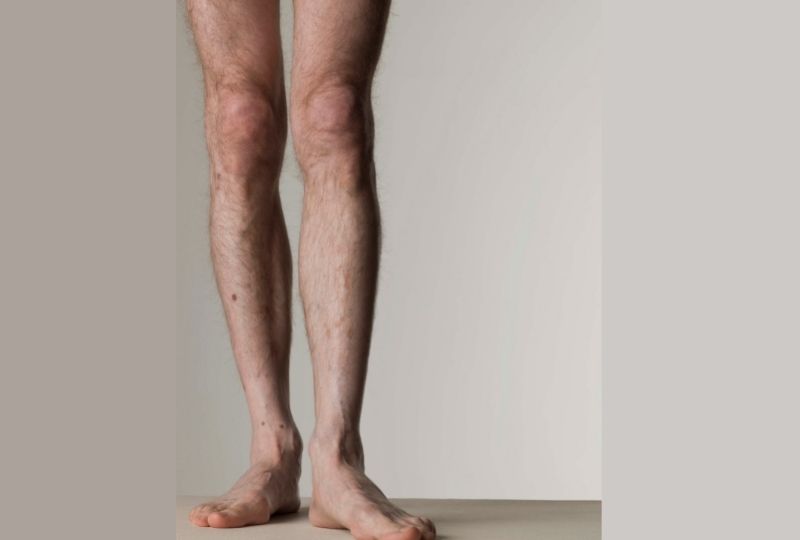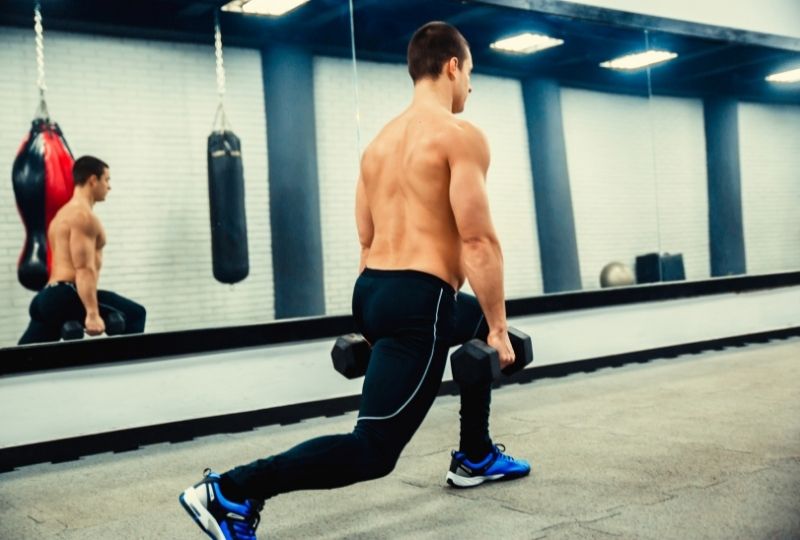What's inside
Having skinny legs can be one of the most frustrating challenges many of us face in and out of the gym.
Whether you have been smashing them for years, hitting your first plateau, or you don’t train at all, skinny legs can be disheartening.
And the pursuit of strong, athletic legs just seems unattainable.
If this is you, don’t worry, I feel your pain.
For many years, before my gym training started, I felt my physique was unbalanced as if my legs would never catch up.
That is until I started taking my leg training seriously and hitting them with everything I had.
So, let’s discuss why those legs are so skinny and what we can do to get them growing.
Why are my legs so skinny?
Related: How To Get Big Legs?

Skinny legs can be due to a number of factors, including insufficient resistance training, poor nutrition, and genetics.
Training your legs two times per week, getting good quality sleep, and eating enough protein can help with stubborn leg growth.
Below, I have listed eight reasons why your legs might be skinny.
Let’s start with the most important – nutrition.
1. Not Enough Fuel
Related: 3000 Calorie Meal Plan
At the top of the list is nutrition. It’s the one thing no one is interested in until they realize it’s why they are not reaching their goals.
Insufficient fuel is one of the main mistakes everyone makes when training.
Often, when we approach the gym for the first time, we see rapid growth as our body is taking on a new and unknown stimulus.
However, when this begins to plateau, we begin to question everything we are doing. Be it our exercises, our programming, and external factors away from the gym such as stress and lack of sleep.
And while these are crucial to muscle growth, we often overlook the key that we have never bothered to focus on, our nutrition.
The recommended daily intake for men is 2,500 calories per day and 2,000 calories per day for women.
For those who are looking to put on mass, a calorie increase of 15% is recommended. This would increase men to 2,875 kcal and 2,300 kcal for women.
This calorie surplus is necessary to facilitate that energy required to train as well as additional protein requirements for muscle hypertrophy.

2. Not Enough Protein
Eating enough calories isn’t simply enough. Protein is required for muscle protein synthesis, essential for hypertrophy.
Too often, when training clients, many would tell me they are increasing calories without considering their protein intake.
This leads to vastly different results.
For muscle hypertrophy, the recommended protein increase is twice the daily amount. Literature indicates the ideal range is 1.6-2.2g per kilogram of body weight.
This can be achieved with protein-rich food such as beef, chicken, and pork. Oats, green beans, and broad beans are ideal for vegans and vegetarians.
From here, supplementation of protein shakes can close the gap.
Protein powder can range from 20g-30g per serving and come in both standard and vegan options.
If you’re looking for a protein powder, but don’t know where to start, check out Top 14 Best Protein Powders Without Artificial Sweeteners

3. Insufficient Resistance Training
Related: Powerbuilding Program (With PDF)
It’s no secret that training legs is hard. This can make it doubly discouraging when we train hard and see little results.
As someone who has struggled with leg development in the past, I feel your pain.
The solution is one you likely will not want to hear. Increase the volume of your leg training.
Training your legs two to three times per week can assist in increasing muscle growth.
For me, decreasing the number of leg exercises within each session, and increasing the number of sessions to two to three times per week has helped me grow my legs.
And due to the reduction of exercises, I am able to focus on the quality of my contractions.
By performing three to six sets of 8-12 repetitions of 60-80% 1RM with the aim to progressively overload, we can be on the front foot to achieve maximal muscle growth.
4. Lack of Consistency
One thing many of us struggle with when it comes to growing muscles is patience.
For many of us, we can see growth in other areas of our body, while our legs lag, shattering our expectations.
While we can see rapid growth and adaptation of neural and muscle fibers through our initial weight training phase, long-term growth can take time.
As lifters, we can be accustomed to this rapid growth, and when things start to slow down, we might quit our training altogether.
The best thing to do in these situations is to change exercises, freshen up our routine, and persist with our progressive overload.

5. Not Targeting All Muscles of the Leg
Related: Bodyweight Workout Plan PDF
The legs contain some of the biggest muscle groups in the body – even in a set of skinny chicken legs.
Consisting of the hamstrings, quadriceps, adductors, and calves, the muscles of the legs are responsible for the function of the hips, knees, and ankles.
However, when we decide it is time to train for mass, we confine ourselves to just the front and back of our thighs. You might stick to movements such as squats, lunges, and hamstring curls.
But to maximize the overall mass of our legs, we need to target all the muscles.
Exercises such as lateral lunges, adductor machines, and experimenting with a variety of different foot positions are a great way to stimulate different fibers of our legs.
This helps to increase mass on the front, back, and sides.

6. Too Much Cardio Training
Related: Cardio On Leg Day
Training in the gym can often mean we are targeting lean muscle mass and cardiovascular fitness.
However, is your cardio routine hampering your quest for giant quads?
The answer is yes and no.
While a short trip post-workout won’t ruin your plans for hypertrophy, longer stints can.
Too much cardio in the form of long-distance running and higher intervals can impair muscle growth.
It is suggested that cardio in shorter intervals, such as high-intensity interval training (HIIT) with a heart rate above 80%, may improve muscle mass.
With this in mind, bouts should be performed between days of heavy resistance training, decreasing the effect on negative effects on muscle growth.
7. Genetics
Further down the list – and something we cannot do anything about – is our genetics. Studies indicate that our muscle fiber-type composition rate of heritability is >50%.
This means that the genes passed down from the previous generation determine the way you look and perform.
It’s frustrating for many, as it’s playing with the hand we are dealt. However, don’t let this discourage you from pursuing a life without skinny legs.
Although this plays an important role in hypertrophy, there are so many controllable factors at your disposal.
Diet and increasing frequency and adherence to training protocols still has a positive effect on improving the strength, size, and physique of the lower body.
8. Supplementation
Related: How Long Does It Take For Creatine To Work?
Supplements can be a great way to get those additional nutrients in if you are struggling to eat enough through your normal daily intake of food.
The benefit of having a protein shake is that it allows for quick and easy intake.
This gives us some much-needed variety outside of protein-rich sources like lean meats that feel like we are consuming day in and day out.
Another common supplement is creatine, recognized as one of the safest and most tested supplements.
Studies on creatine have consistently shown improvements in high-intensity training and greater training adaptations.
This allows us to push harder during our session, requiring less rest between sets and exercises.
Related: Does Creatine Expire
Frequently AskED Questions

How can I fix my skinny legs?
Related: Tired Of Skinny Legs With Big Belly?
Getting rid of skinny legs requires a calorie surplus, progressive overload, and increased training frequency for the muscle groups of the legs.
Training the legs two to three times per week, consuming protein at 1.6-2.2g/kg of body weight, and training consistently can greatly improve your chances of fixing skinny legs.
What causes skinny lower legs?
Skinny legs can be the result of genetics and lack of exercise. It has been noted that over >50% of our muscle fiber-type makeup is hereditary, meaning we get it from past generations in our family.
Are skinny legs healthy?
There’s usually nothing wrong with skinny legs, health-wise.
What determines the overall health of a body part are function, strength, and performance.
Final Thoughts
Skinny legs can feel like a curse, and training them, a drag.
However, all hope is not lost.
Like any training goal, building strong legs requires correct nutrition, increased training frequency, variety, and consistency.
Too often, we only implement a few of these factors and frantically change them hoping for faster results.
My recommendation is to set your goal. Follow your plan. Be patient, and train. Hard.
Is there anything on this list you haven’t tried or have I left something out that has worked for you? Leave a comment below.

